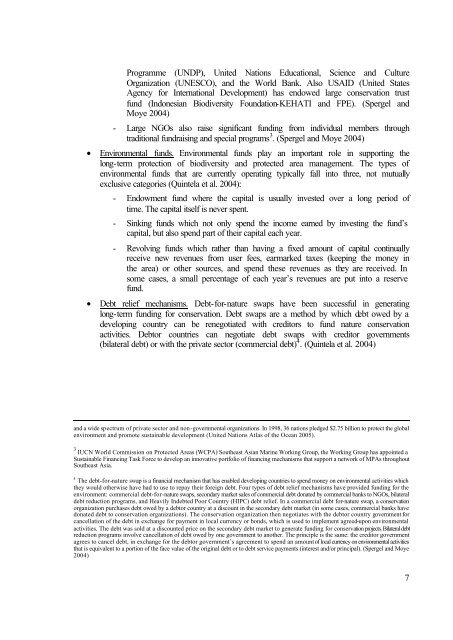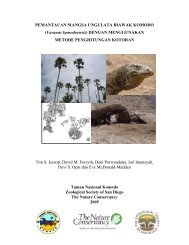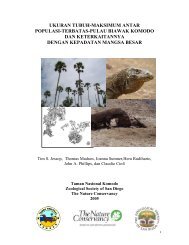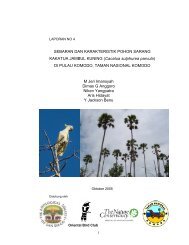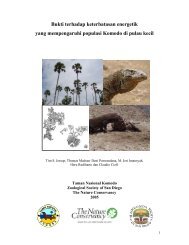Sustainable Financing of MPAs - Komodo National Park
Sustainable Financing of MPAs - Komodo National Park
Sustainable Financing of MPAs - Komodo National Park
Create successful ePaper yourself
Turn your PDF publications into a flip-book with our unique Google optimized e-Paper software.
Programme (UNDP), United Nations Educational, Science and Culture<br />
Organization (UNESCO), and the World Bank. Also USAID (United States<br />
Agency for International Development) has endowed large conservation trust<br />
fund (Indonesian Biodiversity Foundation-KEHATI and FPE). (Spergel and<br />
Moye 2004)<br />
- Large NGOs also raise significant funding from individual members through<br />
traditional fundraising and special programs 3 . (Spergel and Moye 2004)<br />
• Environmental funds. Environmental funds play an important role in supporting the<br />
long-term protection <strong>of</strong> biodiversity and protected area management. The types <strong>of</strong><br />
environmental funds that are currently operating typically fall into three, not mutually<br />
exclusive categories (Quintela et al. 2004):<br />
- Endowment fund where the capital is usually invested over a long period <strong>of</strong><br />
time. The capital itself is never spent.<br />
- Sinking funds which not only spend the income earned by investing the fund’s<br />
capital, but also spend part <strong>of</strong> their capital each year.<br />
- Revolving funds which rather than having a fixed amount <strong>of</strong> capital continually<br />
receive new revenues from user fees, earmarked taxes (keeping the money in<br />
the area) or other sources, and spend these revenues as they are received. In<br />
some cases, a small percentage <strong>of</strong> each year’s revenues are put into a reserve<br />
fund.<br />
• Debt relief mechanisms. Debt-for-nature swaps have been successful in generating<br />
long-term funding for conservation. Debt swaps are a method by which debt owed by a<br />
developing country can be renegotiated with creditors to fund nature conservation<br />
activities. Debtor countries can negotiate debt swaps with creditor governments<br />
(bilateral debt) or with the private sector (commercial debt) 4 . (Quintela et al. 2004)<br />
and a wide spectrum <strong>of</strong> private sector and non-governmental organizations. In 1998, 36 nations pledged $2.75 billion to protect the global<br />
environment and promote sustainable development (United Nations Atlas <strong>of</strong> the Ocean 2005).<br />
3 IUCN World Commission on Protected Areas (WCPA) Southeast Asian Marine Working Group, the Working Group has appointed a<br />
<strong>Sustainable</strong> <strong>Financing</strong> Task Force to develop an innovative portfolio <strong>of</strong> financing mechanisms that support a network <strong>of</strong> <strong>MPAs</strong> throughout<br />
Southeast Asia.<br />
4 The debt-for-nature swap is a financial mechanism that has enabled developing countries to spend money on environmental activities which<br />
they would otherwise have had to use to repay their foreign debt. Four types <strong>of</strong> debt relief mechanisms have provided funding for the<br />
environment: commercial debt-for-nature swaps, secondary market sales <strong>of</strong> commercial debt donated by commercial banks to NGOs, bilateral<br />
debt reduction programs, and Heavily Indebted Poor Country (HIPC) debt relief. In a commercial debt for-nature swap, a conservation<br />
organization purchases debt owed by a debtor country at a discount in the secondary debt market (in some cases, commercial banks have<br />
donated debt to conservation organizations). The conservation organization then negotiates with the debtor country government for<br />
cancellation <strong>of</strong> the debt in exchange for payment in local currency or bonds, which is used to implement agreed-upon environmental<br />
activities. The debt was sold at a discounted price on the secondary debt market to generate funding for conservation projects. Bilateral debt<br />
reduction programs involve cancellation <strong>of</strong> debt owed by one government to another. The principle is the same: the creditor government<br />
agrees to cancel debt, in exchange for the debtor government’s agreement to spend an amount <strong>of</strong> local currency on environmental activities<br />
that is equivalent to a portion <strong>of</strong> the face value <strong>of</strong> the original debt or to debt service payments (interest and/or principal). (Spergel and Moye<br />
2004)<br />
7


